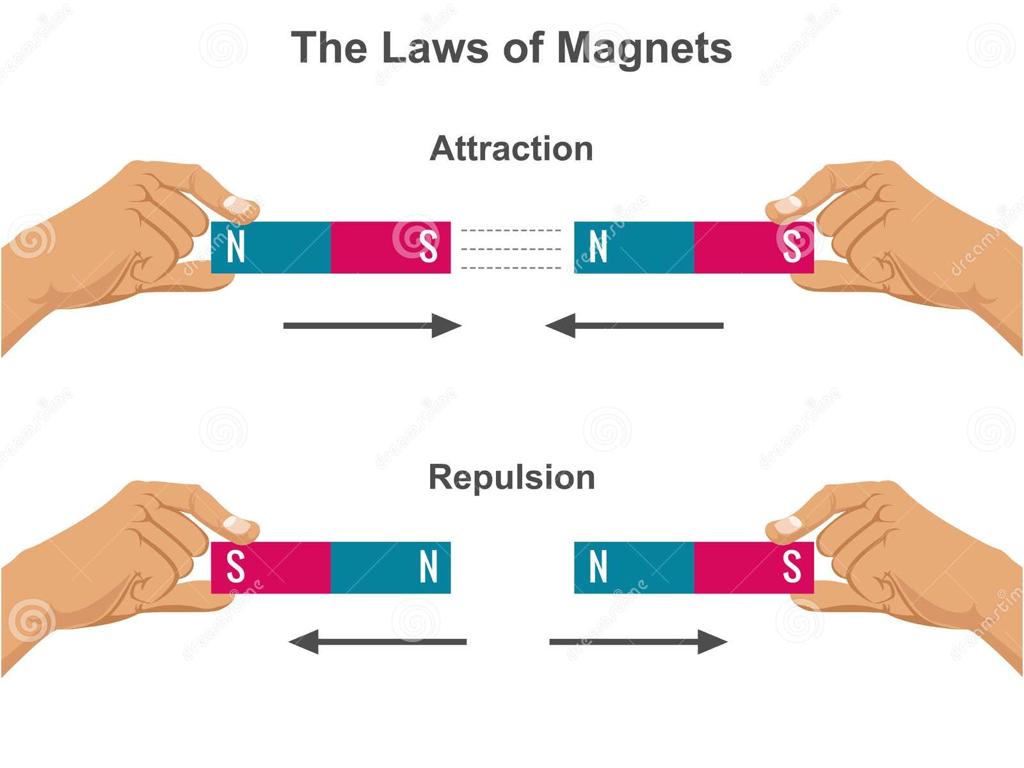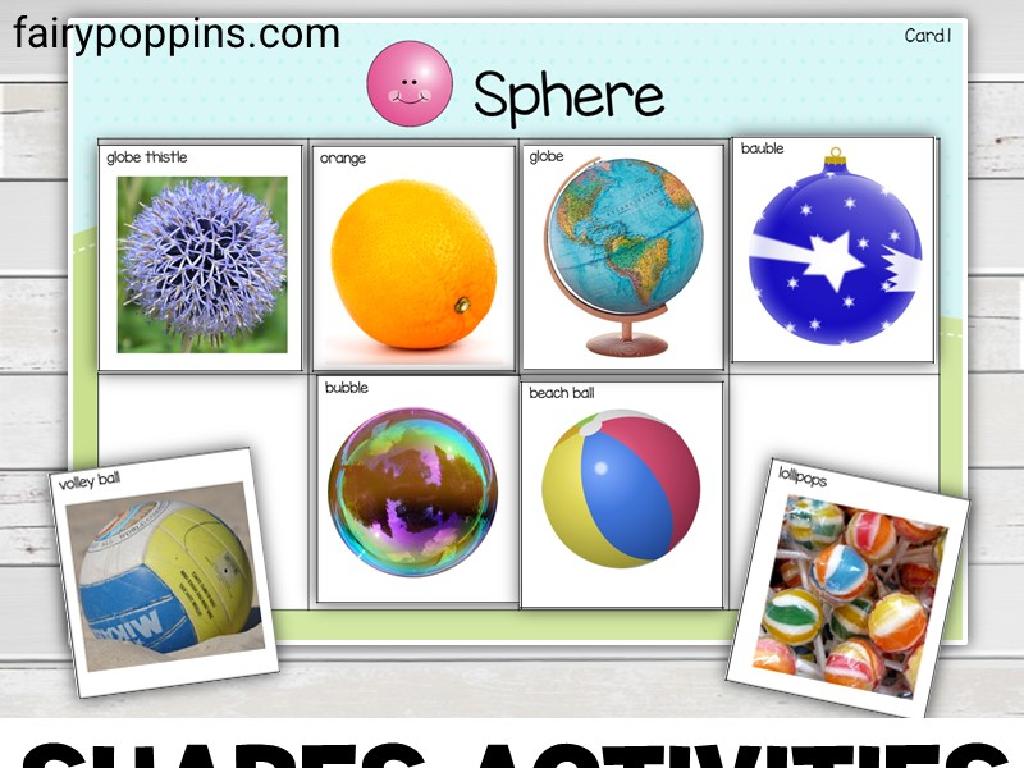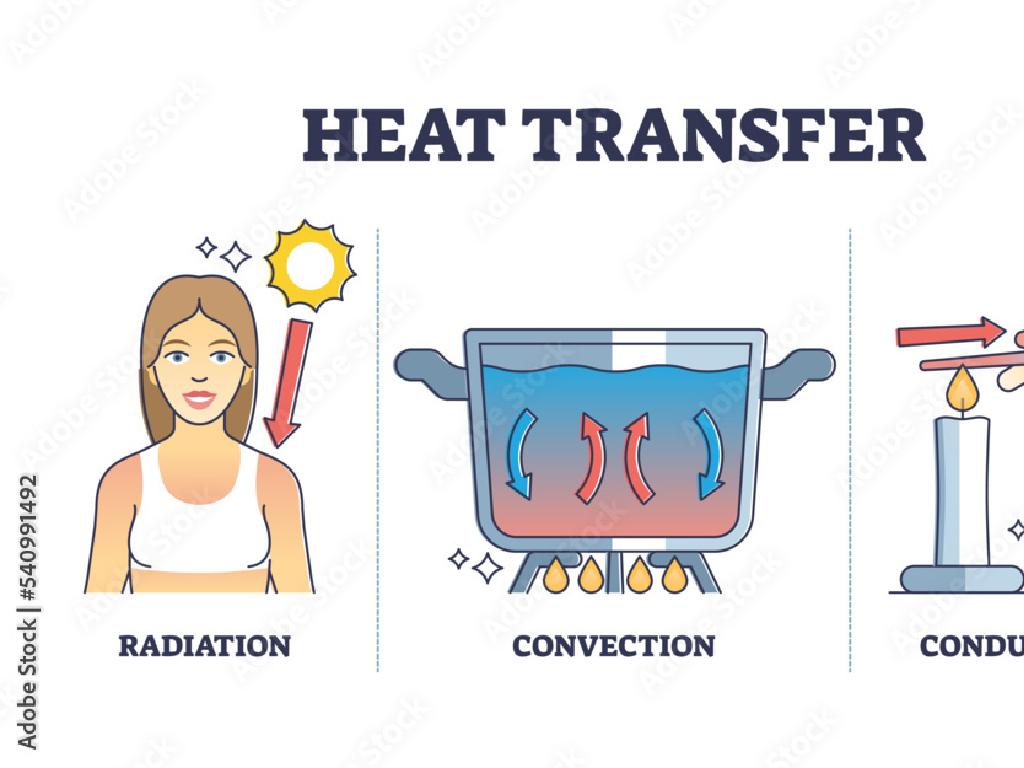Identify Equivalent Ratios
Subject: Math
Grade: Sixth grade
Topic: Ratios And Rates
Please LOG IN to download the presentation. Access is available to registered users only.
View More Content
Welcome to Ratios: Identifying Equivalent Ratios
– What are ratios?
– Ratios compare two quantities, like 2 apples for every 3 oranges.
– Ratios in daily life
– Use ratios when baking, mixing drinks, or comparing prices.
– Finding equivalent ratios
– Equivalent ratios have the same relationship, like 4:6 and 2:3.
– Practice with real examples
|
This slide introduces students to the concept of ratios and their relevance in everyday situations. Begin by explaining that a ratio is a way to compare two quantities, showing how many times one value contains another. Illustrate with simple examples, such as comparing the number of apples to oranges. Highlight how ratios are present in daily activities like cooking or shopping. The main objective is to help students identify equivalent ratios by understanding that they represent the same proportional relationship even though the numbers might be different. Encourage students to find and create their own examples of equivalent ratios to solidify their understanding. Provide practice problems that involve real-life scenarios to make the concept more relatable and engaging.
Understanding Ratios
– Define a ratio
– A comparison of two quantities showing the relative sizes
– Ratios in everyday life
– Examples: recipes, maps, or mixing paints
– Numerical and word ratios
– 3:1 or ‘3 to 1’ shows the same ratio
– Recognizing equivalent ratios
– Equivalent ratios have the same value when simplified
|
Begin by defining a ratio as a way to compare two quantities, which can be written in various forms such as fractions, with a colon, or in words. Provide relatable examples that students encounter in daily life, such as recipes (2 cups of flour to 1 cup of sugar), distances on a map, or mixing colors. Explain how ratios can be expressed both in numbers (like 3:1) and words (‘three to one’). Emphasize the concept of equivalent ratios by showing that different ratios can represent the same relationship if they can be simplified to the same value. For instance, 6:2 is equivalent to 3:1 because both simplify to the same ratio when divided by their greatest common factor. Encourage students to find and share examples of ratios from their surroundings to reinforce their understanding.
Representing Ratios
– Understanding ratio notation
– A ratio shows how much of one thing there is compared to another, e.g., 1:2 (one to two)
– Ratios as fractions
– Ratios can also be written as fractions, like 1/2, showing the same relationship
– Exploring part-to-part ratios
– Part-to-part compares different parts of a group, like apples to oranges in a fruit bowl
– Grasping part-to-whole ratios
– Part-to-whole compares one part to the entire group, like apples to all fruits in the bowl
|
This slide introduces students to the concept of representing ratios in different forms. Start by explaining that a ratio is a way to show the relationship between two quantities. Use the colon notation to illustrate this and provide examples. Then, show how these ratios can be written as fractions, which they are already familiar with from previous math lessons. Discuss the difference between part-to-part and part-to-whole ratios with real-life examples, such as comparing the number of apples to oranges (part-to-part) or the number of apples to the total number of fruits (part-to-whole) in a bowl. Encourage students to think of their own examples and to practice writing ratios in both forms.
Understanding Equivalent Ratios
– Defining equivalent ratios
– Ratios with the same value but different numbers, e.g., 2:4 and 4:8
– Multiplication & division in ratios
– Multiply or divide both terms by the same number to find equivalent ratios
– Consistent ratio relationships
– The relationship between numbers in a ratio must stay the same
– Exploring ratio equivalence
|
This slide introduces the concept of equivalent ratios, which are two ratios that express the same relationship between numbers, even though the numbers themselves might be different. Students should understand that by multiplying or dividing both terms of a ratio by the same non-zero number, they can find an equivalent ratio. Emphasize that the relationship between the numbers in a ratio is what’s important, not the actual numbers. Provide examples such as 2:4 and 4:8 to show equivalence and ask students to generate their own examples. Encourage them to explore how changing one term of the ratio affects the other to maintain equivalence.
Finding Equivalent Ratios
– Multiply to find equivalent ratios
– If we have a ratio of 2:3, multiplying both by 2 gives us 4:6, which is equivalent.
– Divide to simplify ratios
– To simplify 4:6, we divide both by 2 to get back to 2:3.
– Class practice example
– Let’s try finding equivalent ratios for 3:4 together as a class activity.
|
This slide is aimed at teaching students how to find equivalent ratios by using multiplication and division. Start by explaining that multiplying or dividing both terms of a ratio by the same number gives an equivalent ratio. Use clear examples to demonstrate this concept. For multiplication, show that if you have a ratio like 2:3, multiplying both numbers by 2 gives you an equivalent ratio of 4:6. For division, explain that you can simplify ratios by dividing both terms by their greatest common factor, like simplifying 4:6 back to 2:3 by dividing both by 2. The class practice example should be interactive, with students working together to find equivalent ratios for a given ratio, such as 3:4. Provide guidance and support as they work through the process. The goal is for students to understand that equivalent ratios are just scaled versions of the same relationship.
Real-World Ratios: Let’s Cook!
– Ratios in recipes explained
– A recipe ratio like 2 cups flour to 1 cup sugar can be scaled up or down.
– Adjusting recipes with ratios
– If you double the ingredients, you double the ratio. For 4 cups flour, how much sugar?
– Group activity: Recipe adjustment
– In groups, choose a recipe and adjust it to serve more or fewer people.
|
This slide introduces students to the concept of equivalent ratios through the practical example of cooking. Begin by explaining how ratios are used in recipes to maintain flavor and texture. Discuss how changing the number of servings requires adjusting the ratios accordingly. For the group activity, have students select a recipe and work together to adjust the ingredients for a different number of servings. Provide guidance on how to multiply or divide the ratios to maintain the recipe’s integrity. Possible activities could include adjusting a cookie recipe to serve a class party or reducing a pasta sauce recipe for a smaller family dinner. Encourage students to think critically about the math behind everyday activities like cooking.
Let’s Practice: Equivalent Ratios
– Solve practice problems on ratios
– Pair up for collaborative learning
– Work with a classmate to tackle ratio problems
– Discuss solutions with your partner
– Compare your answers and reasoning
– Share findings with the class
|
This slide is designed to engage students in active learning through practice problems on identifying equivalent ratios. Students should first attempt to solve problems individually to assess their understanding. Then, they will pair up with a classmate to discuss their solutions and methods. This collaborative approach allows students to learn from each other and clarify any misunderstandings. Finally, each pair will have the opportunity to share their findings with the class, fostering a community learning environment. The teacher should circulate the room, providing guidance and support where needed. Possible activities could include creating ratio tables, finding equivalent ratios for given situations, or even using manipulatives to represent ratios physically.
Class Activity: Ratio Scavenger Hunt
– Find objects with ratios in classroom
– Create equivalent ratios from objects
– For example, if you find 2 pencils for every 3 pens, what’s an equivalent ratio?
– Present your ratio findings
– Discuss the concept of equivalence
– Understand that different ratios can represent the same relationship
|
This interactive class activity is designed to help students identify and understand equivalent ratios in a fun and engaging way. Students will search the classroom for objects they can use to form ratios. They might find pairs of items, like pencils to erasers, and then create equivalent ratios (e.g., 2 pencils:3 erasers is equivalent to 4 pencils:6 erasers). After gathering their examples, students will present their findings to the class, explaining how they determined the ratios to be equivalent. This will reinforce their understanding of the concept of equivalence in ratios. As a teacher, be prepared to guide them through creating equivalent ratios and to facilitate a discussion on why different ratios can represent the same relationship. Possible variations of the activity could include finding ratios in pictures, textbook examples, or creating ratios with classmates (e.g., students with glasses to students without).
Conclusion: Understanding Equivalent Ratios
– Recap on equivalent ratios
– Equivalent ratios have the same value when simplified.
– Ratios in math and real life
– Used in recipes, maps, and buying in bulk.
– Homework: 3 sets of equivalent ratios
– Find examples from daily life and show your work.
|
As we wrap up, let’s review the concept of equivalent ratios, which are two or more ratios that have the same relationship between their numbers. Understanding ratios is crucial as they are used in various real-life situations such as cooking, where recipes are scaled, or in understanding distances on a map. For homework, students are expected to find and write down three sets of equivalent ratios from their daily experiences. This could be from cooking, shopping, or any other activity. Encourage them to explain how they determined the ratios are equivalent. This exercise will help reinforce their understanding and show them the practical application of ratios in everyday life.





